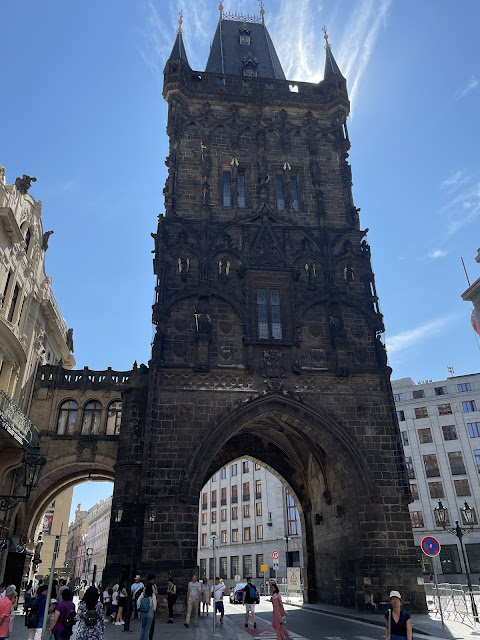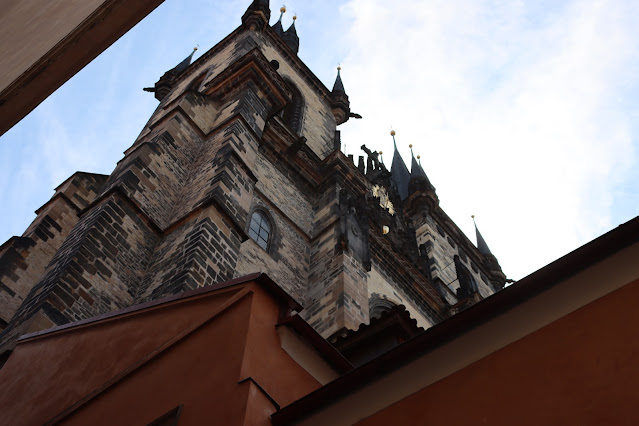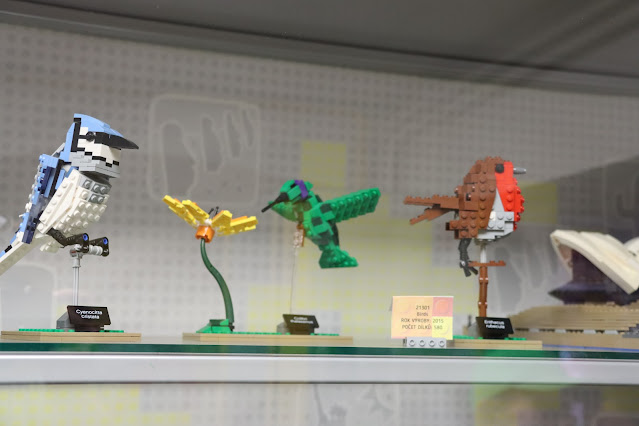We started the day with a bit of a sleep-in and then caught a tram into Prague. We got off as close to the Town Square as we could.
Our first stop was Prašná Brána, the Powder Gate Tower. The tower is 65m tall and construction was started in the 1470s. Work was delayed and the gate was finally finished in the 1500s. It was damaged badly due to Prussian shelling in 1757. The tower is believed to be called the Prašná Brána as gunpowder was stored in it in the mid 1700s. The tower was reconstructed in Neo-Gothic style in the late 1800s.
We then walked through the gate and to the Town Square. Our next stop was the Kostel Matky Boží před Týnem, The Church of Our Lady before Týn.
The first Our Lady before Týn Church was built in 1256 to replace an existing church for foreign merchants from Týn. The existing church was constructed in the 14th - 15th centuries. In 1620 the Bohemians lost the Battle of White Mountain to the Habsburgs, and the church was stripped of sculptures of the Bohemian King George of Poděbrady and his symbol, a golden chalice, and replaced with those of the Virgin Mary. The chalice was returned to the church in 2017. When the first Our Lady Before Týn church was built, there were houses in front of it, so the new church needed to be built behind them, meaning that part of its façade is blocked and only visible after entering a narrow alleyway.
Directly across from the church was the Town Square, including the Town Hall and Astronomical Clock.
The Old Town Hall, or Staroměstská radnice, was built in 1338, initially as a large house the town purchased from the Volflin family. The town hall then grew, with the tower and additional buildings being added. This leads the town hall to have a patchwork type appearance as it is essentially made up of several smaller houses.
 |
| Town Square |
Just outside the town hall was the Marian Column (
Mariánský sloup) a column with the statue of the Virgin Mary on top, that was erected in 1650. I was originally confused because I couldn't see it in Google Maps, and it doesn't look like something they would just remove:
 |
| Marian Column |
 |
| It's missing on Google Maps... |
It took a bit of a search online to find out why. The google image was taken in 2009 and the Column was demolished in 1918 when Austria-Hungary fell, and only rebuilt in 2020.
One of the most famous parts of the town hall is the Horologe, Prague Orloj, an astronomical clock built in the 1400s. The clock has three parts, an astronomical dial showing the position of the sun and moon, statues of the Catholic Saints and Death, and a calendar dial showing the months.
 |
| Prague Orloj |
The clock is the third oldest astronomical clock in the world and the oldest still operating.
From Wikimedia (https://commons.wikimedia.org/w/index.php?curid=1516204), here is a detail of the clock functions:
 |
| Astronomical Dial |
The Astronomical Dial consists of several parts.
The hands meet at the centre of the clock, which shows Prague's location on the world map.
The outer black circle is Gothic Numerals, the golden numbers on light blue are Roman Numerals and the black numbers on blue are Arabic numerals. These show the current time.
The blue represents the daylight hours, the orange is the horizon and the black field is night.
There are Latin words that are partially obscured by the inner dial that read ORTUS (sunrise), AURORA (sunrise), OCCASUS (Sunset) and CREPUSCULUM (dusk).
There are two hands on the clock, which are slightly obscured in that picture, one with a sun and a hand with pointing fingers (currently under the sun) and a moon.
The sun moves up and down the hand to show the real position of the sun in the sky. When it is in blue it is day, black is night and orange is dusk or dawn.
The golden hand shows the current time (however it does not adjust for daylight savings so we needed to add an hour). (so the time is about 11am)
The moon shows the location of the moon - currently in the lower left in black, but also shows the phase of the moon by how much white is shown on the black ball.
The middle dial shows the twelve symbols of the Zodiac with the outside lines marking the amount of sunlight present in 5 day chunks - The summer Zodiac signs, for example Cancer (♋︎) has larger segments than the winter ones such as Aquarius ♒. The sun hand shows that we are currently in the last part of Cancer Zodiac dates (June 21 - July 22 - its currently 14th July) and almost into Leo ♌︎.
The clock also shows how many hours of light remain. If you count back from the hand to the Gothic Number 24:
you can determine how many hours are left until sunset. The Gothic time started at sunset, hence the 24 being the time the sun would set. So there are about 9 hours left on the clock above.
The bottom of the clock shows a calendar:
 |
| Calendar Dial |
The outer grey circle lists the names of all days of the year - the Patron Saint associated with that day. The current day and saint are displayed at the top.
The middle of the circle is the Prague coat of arms and the other circles show the activities generally undertaken in months of the year. The smaller circles show the Zodiac symbols.
The clock also has 9 figures - looking at the picture from before:
The small figure in the top middle is the Cockerel, which crows to mark the end of the March of Apostles which occurs every hour. Unlike the other wooden sculptures, this one is gold plated.
The two figures on the top left are Vanity and Greed:
The top right is Death and Turk (considered to be Lust).
The lower left is Philosopher and Archangel Michael and the lower right is Astronomer and Chronicler.
We didn't stay at the clock too long (despite how long-winded my description of it was), because it was so crowded. Instead we ducked down a side alley and picked up a Chimney Cake:
We then walked towards the Charles Bridge, passing the Church of St Francis of Assisi, built in 1679 near the Charles Bridge:
We then reached the Karlův most, Charles Bridge. The bridge was built in 1357 to replace the Judith bridge (1158) as the only crossing of the river Vltava until 1841:
 |
| Old Town Bridge Tower |
 |
| View of Prague Castle from the bridge |
 |
| Lesser Town Bridge Tower |
 |
| View of Prague Castle from the bridge |
 |
| View of the Charles from Mánesův most |
 |
| Inside the roof of the Old Town Bridge Tower |
 |
| "Are you still hiding behind the pillar I'm standing on? I can see you..." |
 |
| The bridge was pretty crowded |
 |
| "If you don't climb down right now I'm going to whack you with this book" |
 |
| "How Cameron feels having to wake up at 8am..." |
 |
| "You can plead as much as you like, but it's the baby's turn with the giant stone ball" |
 |
| "Excuse me Miss, you seem to be missing your top, I can't bless those!" |
 |
| "After several weeks, John finally managed to climb the mountain of tiny lions" |
 |
| I don't really have a comment for this, other than Jesus' pose being a bit strange. |
After crossing the bridge we headed up the slope to the Castle. We did pass these really cool fence posts in the parking area:
One thing I haven't made a huge note of so far, has been the heat. The temperature for most of the trip was around 30-32 degrees with high humidity. That doesn't seem too bad by Aussie standards, but we have shade, air conditioning and also the heat hits different here (maybe its the humidity). But either way it was HOT and the weather channels were putting out extreme heat warnings. This made all the walking and climbing a lot harder than it should have been. Most days we were clocking up around 100+ flights of stairs and over 20-30,000 steps.
But the views from the top of the stairs were worth it:
 |
Church of Our Lady before Týn |
 |
| Žižkov Television Tower |
 |
| St. Nicholas Cathedral |
 |
| Petřín Tower |
 |
| Prague Castle |
 |
| Prague Castle Gates |
 |
| "Paul failed the Baseball section of his Sports Lessons" |
 |
| Prague Castle |
 |
| Cameron taking in the scenery |
So on to my next point of confusion. Apparently there are three Churches of St Nicholas in Prague. The first, on Staré Město is located in the Town Square and was built in the 1730s:
The second is on Malá Strana below the palace and has the distinctive dome:
The final one is on Vršovice, but we did not see that one.
Heading back into Old Town, we passed the Rudolfinum, the home of the Czech Philharmonic Orchestra since 1885:
We then headed to the Máj, a famous department store in Prague, that has recently had a new art installation - A spitfire aircraft with butterfly designs. The sculpture is a tribute to the Czechoslovak fighter pilots who served with the RAF in WWII. The butterfly is seen as the symbol of peace and the spitfire as one of war:
Our next stop was the Museum of Bricks in Prague, the largest private Lego museum in the world:
 |
| The Old Town Hall Tower and Astronomical Clock |
 |
| Trevi Fountain |
 |
| Lego Castle |
 |
| Muppets Mini-Figs |
 |
| Prague National Museum |
 |
| Powder Gate |
 |
| Pirate Ships |
 |
| Pirates |
 |
| Star Wars |
Once we finally managed to drag the kids (and me) out of the Lego museum, we headed to our final stop - Wenceslas Square (Václavské náměstí), the center of New Town.
Unfortunately most of it was closed off, so we didn't get to see too much:
 |
| National Musuem |
 |
| Statue of Saint Wenceslas |
We caught the tram back to our apartment for our last night in Prague before we headed off to Vienna the next morning.












































































No comments:
Post a Comment